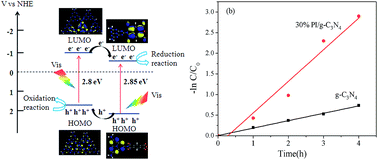Constructing metal-free polyimide/g-C3N4 with high photocatalytic activity under visible light irradiation
Abstract
A novel metal-free polyimide (PI)/g-C3N4 heterojunction has been prepared through a sonochemical approach. The PI/g-C3N4 composite exhibits an extraordinary high photogenerated carrier separation efficiency and sequentially a high-efficiency photocatalytic capability in the degradation of 2,4-dichlorophenol (2,4-DCP) under visible light irradiation. In particular, the optimum photocatalytic activity of the PI/g-C3N4 composites with weight ratio of PI at 30% is almost 3.8 times as high as that over g-C3N4. Furthermore, it was found by experimental analysis and density functional theory (DFT) calculations that the superior photocatalytic performance of the composites can be attributed to the facile band alignment and different electronic structure of g-C3N4 and PI components in the heterojunction for efficient charge separation and transfer.


 Please wait while we load your content...
Please wait while we load your content...